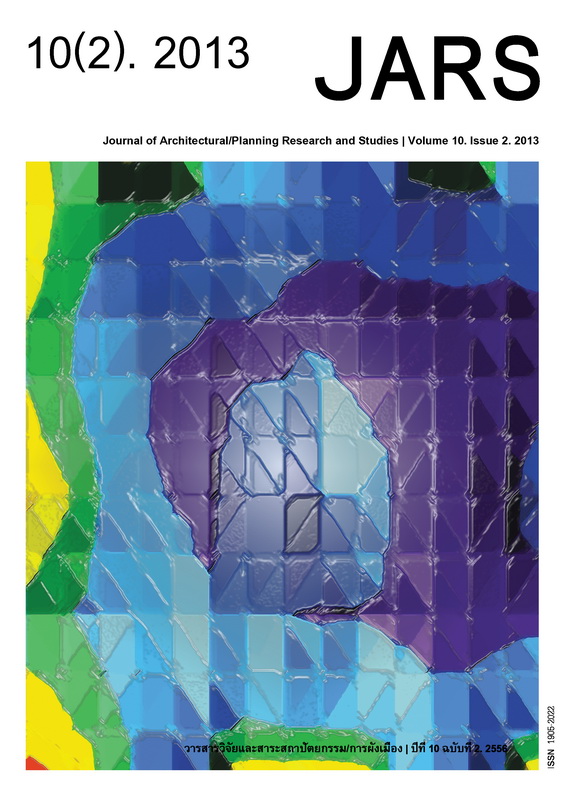Agent-based Modeling and Disaster Management
Main Article Content
Abstract
Social simulation is usually used to analyze issues in social science and to study behaviors of people inspecific events. Unlike scientific experiments in other hard sciences, which can be tested in a closed environmentor in a laboratory, social simulation applies computation methods to examine social phenomena.
In urban planning, understanding stakeholders—which include residents, businesses, factories, and localgovernments—is one of the important factorsin a successful project. In many cases, these stakeholders areheterogeneous individuals who may have different behaviors. Thus, to effectively solve issues in urban planning,planners need to understand stakeholders. Agent-based modeling (ABM) is widely used to analyze behaviors ofstakeholders under implementation of urban policies, especially in the events of natural disasters, which areconsidered as complex systems. In these analyses, spatial structures of affected areason which stakeholdersare located and interact are a crucial ground of ABM. Together with the development of geographic informationsystems (GIS), the database systems and analyses of ABM become more accurate and reliable, especially onphenomena with the complexity of spatial structures.
This review article explains the development and definition of ABM and introduces software and toolkitsfor building an agent-based model, as well as reviews articles and research that use ABM to analyze the issuesin theoretical testing and urban planning. Schelling’s Segregation and Hotelling’s Law models are discussed asexamples of theoretical testing while robbery and driving behavior models are selected as the implications ofABM in urban planning. This article also focuses on the use of ABM on natural disaster policies and managementusing case studies of Japan and the United Kingdom.
Downloads
Article Details

This work is licensed under a Creative Commons Attribution-NonCommercial-NoDerivatives 4.0 International License.
All material is licensed under the terms of the Creative Commons Attribution 4.0 International (CC-BY-NC-ND 4.0) License, unless otherwise stated. As such, authors are free to share, copy, and redistribute the material in any medium or format. The authors must give appropriate credit, provide a link to the license, and indicate if changes were made. The authors may do so in any reasonable manner, but not in any way that suggests the licensor endorses you or your use. The authors may not use the material for commercial purposes. If the authors remix, transform, or build upon the material, they may not distribute the modified material, unless permission is obtained from JARS. Final, accepted versions of the paper may be posted on third party repositories, provided appropriate acknowledgement to the original source is clearly noted.
References
Chang, S. E. (2009). Infrastructure resilience to disasters. The Bridge, 39(4), 36–41.
Comfort, L. K., Ko, K., & Zagorecki, A. (2004). Coordination in rapidly evolving disaster response systems: The role of information. American Behavioral Scientist, 48(3), 295–313.
Dawson, R. J., Peppe, R., & Wang, M. (2011), An agent-based model for risk-based flood incident management. Natural Hazards, 59(1), 167–189.
Donaghy, K. P. (2009). Modelling the economy as an evolving space of flows. In A. Reggiani & P. Nijkamp (Eds.), Complexity and spatial networks: In search of simplicity. Berlin: Springer-Verlag.
Donaghy, K. P. (2012). Walter Isard’s evolving sense of the scientific in regional science. International Regional Science Review, 37(1), 78-95.
Durlauf, S. N. (2005). Complexity and empirical economics. The Economic Journal, 115, 504, 225–243.
Epstein, J. M., & Axtell, R. (1996). Growing artificial societies: Social science from the bottom up. Washington, D.C.: Brookings Institution Press.
Gardner, M. (1970). Mathematical games: The fantastic combinations of John Conway’s new solitaire game “life”. Scientific American, 223, 120–123.
Gilbert, G. N. (2008). Agent-based models. Los Angeles: Sage Publications.
Heppenstall, A. J., Batty, M., Crooks, A. T., & See, L. M. (2012). Agent-based models of geographical systems. Dordrecht: Springer Netherlands.
Hotelling, H. (1929). Stability in competition. The Economic Journal, 39, 153, 41–57.
Lampert, R. (2002). Agent-based modeling as organizational and public policy simulators. PNAS, 99(3), 7195–7196. Retrieved December 2013, from www.pnas.org/cgi/doi/10.1073/pnas.072079399
Liu, Y., Okada, N., Shen, D., & Li, S. (2009). Agent-based flood evacuation simulation of life-threatening conditions using vitae system model. Journal of Natural Disaster Science, 31(2), 33–41.
Macal, C. M., & North, M. J. (2009). Agent-based modeling and simulation. In M. D. Rossetti, R. R. Hill, B. Johansson, A. Dunkin & R. G. Ingalls (Eds.), Proceedings of the 2009 Winter Simulation Conference (pp. 86–98). Piscataway: IEEE.
Macal, C. M., & North, M. J. (2010). Tutorial on agent-based modelling and simulation. Journal of Simulation, 4(3), 151–162.
Malleson, N. (2011). Repast city: A demo virtual city. Retrieved August 2011, from http://portal.ncess.ac.uk/wiki/site/mass/repastcity.html
Mansury, Y. S. (2013). Simulations in regional science: The founder’s take on agent-based models in regional science. The newsletter of the RSAI, 10, 3–7. Retrieved from http://www.regionalscience.org/images/PDF/Newsletter%202013%20November.pdf
North, M. J., Collier, N. T., Ozik, J., Tatara, E. R., Macal, C. M., Bragen, M., & Sydelko, P. (2013). Complex adaptive systems modeling with Repast Simphony. Complex Adaptive Systems Modeling. Heidelberg: Springer. Retrieved from http://www.casmodeling.com/content/1/1/3
Okada, N. (2006). City and region viewed as vitae system for integrated disaster risk management. Annuals of Disaster Prevention Research Institute Kyoto University, 49B, 131–136.
Ottino, B., Stonedahl, F., & Wilensky, U. (2009). NetLogo Hotelling’s Law Model. Center for Connected Learning and Computer-Based Modeling, Northwestern University, Evanston, IL. Retrieved from http://ccl.northwestern.edu/netlogo/models/Hotelling’sLaw
Schelling, T. C. (1972). Dynamic models of segregation. Journal of Mathematical Sociology, 1(2), 143–186.
Takahashi, S., Sallach, D. L., & Rouchier, J. (2007). Advancing social simulation: The First World Congress. Tokyo: Springer.
Tontisirin, N. (2013). Three Essays in Residential Locations, Household Commuting Patterns, and Spatial N-Person Prisoner’s Dilemma: The Case Study of Bangkok, Thailand. Doctoral dissertation. Cornell University, Ithaca, NY.
von Neumann, J. (1966). Theory of Self-Reproducing Automata, edited by A.W. Burks. Urbana: University of Illinois Press.
Wilensky, U. (1997). NetLogo Segregation model. Center for Connected Learning and Computer-Based Modeling, Northwestern Institute on Complex Systems, Northwestern University, Evanston, IL. Retrieved from http://ccl.northwestern.edu/netlogo/models/Segregation
Wilensky, U. (1999). NetLogo. Center for Connected Learning and Computer-Based Modeling, Northwestern University, Evanston, IL. Retrieved from http://ccl.northwestern.edu/netlogo/

